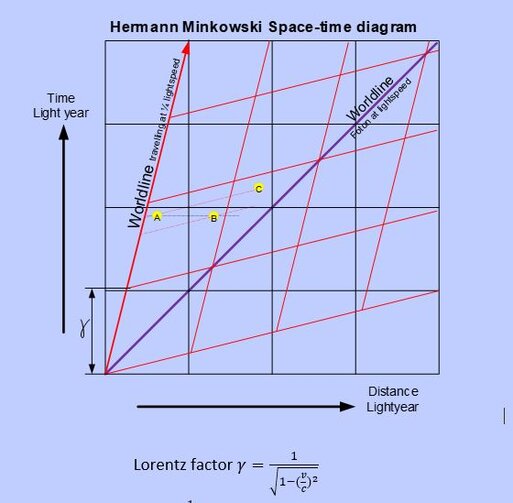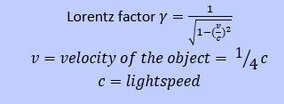Timedifference
Time
Time, A straight forward concept. It contains the past, present and future. So pretty convenient from that point of view. It’s the relativity of that “point of view” what makes time less predictable.
It started with Einstein who came up with the theory of special relativity. Special relativity linked space and time to one, “Spacetime”. According to Einstein “The laws of physics are the same in all inertial reference frames” and “speed of light is the same regardless of the motion of the observer or source”
It was Hermann Minkowski who constructed a graphical space-time diagram. His diagram uses distance on the X-axis and time on the y-axis, both with dimension lightyear. The purple 45degree line is the line on which a photon would travel ( lightspeed). This line is called the “Worldline”. The red frame is a different inertial frame. It is that from an object (think of an comet for example) traveling at ¼ of lightspeed. This red frame shows a certain contraction in time and distance (space-time) in relation to the black original diagram. The contraction can be constructed with use of the Lorentz factor ɣ. The Lorentz factor is named after Hendrik Lorentz and describes time dilatation and length contraction



At ¼ lightspeed the Lorentz factor is 1.032795559. So with his factor, previous red frame is constructed. Lets look to the three points A,B and C. According to the original frame of reference ( black diagram) events A and B are occurring at the same time and event C is happening later. But imagine ‘sitting on the comet’ in a nice comfy beach chair and looking to the same events as they occur. The difference now is that we refer from the red frame of reference. So from the comets point of view event B is first and then followed by event A and C simultaneously. So apparently time is not fixed and as shown here on the X-axis, space neither.
The Minkowski diagram is all about special relativity, but there is also general relativity.
General relativity is known as the influence of gravity on time. A well-known explanation is that gravity is bending the fabric of space time. Einstein’s solution to calculate general relativity is based on field equations. Field equations are pretty abstract and a good mathematical knowledge is needed.
The effects of general and Special relativity are different. For example when checking the time development on a GPS satellite, two situations can be distinguished, A) the effect of general relativity is that time is 45 micro sec faster per day. B) Special relativity however causes the time on the satellite to get 7 microsec behind.
https://asd.gsfc.nasa.gov/blueshift/index.php/2015/
https://www.astronomy.ohio-state.edu/pogge.1/Ast162/Unit5/gps.html11/25/100-years-of-general-relativity/
So how does the hypothesis as described in this website explain time difference between a GPS Satellite in orbit in relation to earth’s surface. This hypothesis states that that with increasing gravity the atom gets compressed. The other way around is that a hydrogen in space at the GPS satellite is slightly larger than that of an hydrogen atom on Earth. The difference in size can be expressed in an ratio. Reminder is that this hypothesis explains the timedifference based on gravity, it will therfore explain the general relativity part of time difference
This rate of expansion is useful because it can be used for defining the length of the circumference of the orbit of a GPS satellite, When measuring the circumference and multiplying it with this ratio, the circumference, would be 0.7874 meters larger than expected.
This looks minimal and neglectable, but when using this distance, it can very well describe the time difference.
A nice visual explanation is added.